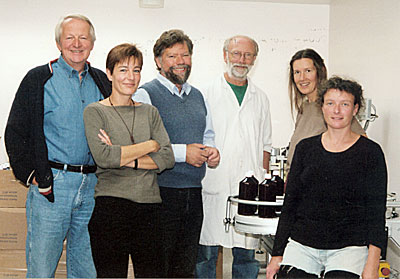 |
| Erik Nielsen, third from left, with some of the Biosa team in Frederiksvaerk, Denmark. |
Story and photos by Ron Rosenthall
North Americans may soon associate Denmark with more than Hamlet, blue cheese and the Little Mermaid: We may add products from Biosa Danmark ApS that could improve the well-being of farm animals, the yield and quality of produce, and our own health. The Danish firm sells its products in over 30 countries and is establishing offices and a distribution network in the New World. As The MOF&G went to press, it was seeking OMRI (Organic Materials Review Institute) approval for the products.
The three principal Biosa products are organic herbal/microorganism blends. Using microorganisms to treat soil, humans and animals is not new, although agricultural use has been confined generally to Asia. In fact, Biosa CEO Erik Nielsen was introduced to the potential of microorganisms in agriculture while consulting in Thailand in 1994 for the Danish ministry of the environment. Professor Teruo Higa of the University of the Ryukyus in Okinawa, Japan, developer of a product called EM (Effective Microorganisms – or Efficient Microorganisms, depending on where it’s produced), enlightened Nielsen and invited him to Japan. Subsequently Higa granted Nielsen permission to work with EM in Europe and even sent one of his students to Denmark for a year to teach Nielsen production processes.
Nielsen experimented until he developed safe and effective products. Unlike EM, Terra Biosa includes plants (largely medicinal herbs), uses other sugars in addition to molasses for fermentation, and is fermented with selected lactic-acid and other probiotic cultures that are more productive than earlier strains or blends.
Nielsen had an important influence on the Danish organic-farming scene until he proved too radical for it. His reflections and admissions provide a sense of that. “I could tell you that this or that herb is known to be good for one thing or another,” he told me in 2003 in Frederiksværk, where the operation is located, in northern Zealand, Denmark’s biggest island. “And that this or that traditional medicine recognizes some virtue or quality in this or that herb. But,” he admitted (and herbalists will be sympathetic), “I used a particular herb because it felt right.”
As much as Vita Biosa (for humans) and Animal Biosa quickly restore the natural microbial balance in digestive systems, enabling the body to maximize nutrients from food and providing a basis for good health generally, so Terra Biosa increases the biological activity of soil, speeding decomposition of organic materials and releasing nutrients to benefit growing things. As the activity and populations of nitrogen-gathering bacteria in the soil increase, so do plant root systems and, thus, absorption of nutrients, resulting in higher yields and less need for fertilizer. (Biosa can also help recycle contaminated earth, clean septic tanks and restore the health of lawns and water.)
One inspiration for Nielsen’s experiments with microorganisms was that “in organic farming [in Europe] we … couldn’t produce enough.” Terra Biosa, he feels, changes that. Only limited, preliminary scientific experiments have been done with Biosa (see www.biosasolutions.com), but testimonials abound.
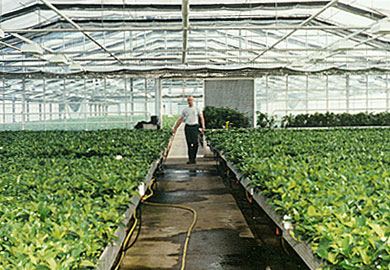 |
| Jørgen Brandt Hansen, amid a sea of Biosa-treated gardenias outside Sabro, Denmark. |
Cutting Gardenia Production Costs
To see the effects of Biosa, I visited operations that included Jørgen Brandt Hansen’s 11/2 acres of gardenias on Jutland, part of Denmark that is an extremity of the European mainland. Hansen inherited his gardenia obsession from his father. He also inherited almost 65,000 square feet of greenhouse space where he raises 300,000 gardenias at a time – a year’s worth of sales. Further, he inherited his father’s commitment to Terra Biosa, the elder Brandt Hansen having been the first to use Biosa in indoor floriculture.
Gardenia cuttings get a head start by being dipped into a solution of Terra Biosa and an organic aphid treatment. Then Brandt Hansen adds Terra Biosa to recycled water that subirrigates the gardenias. Before using Terra Biosa, Brandt Hansen lost 20 to 40% of his product, mostly to root and leaf rot. After one year of Biosa use, that loss dropped to 5% and is now virtually zero. Brandt Hansen has more salable plants and saves one to two weekly salaries for employees who previously did nothing but remove dead leaves or plants.
Creating the Smell of Money
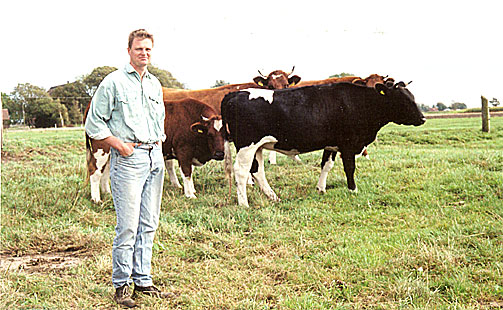 |
| Thomas Langholz with a few of his sleek and fly-free cows outside Wilster, Schleswig-Holstein, Germany. |
The Langholz family near Wilster, in northern Germany, had a problem with the stink of cow manure and with flies in their house, which adjoined a cow barn. Uta Langholz read a magazine article about microorganisms, and the Internet led her to Biosa. Her husband, Thomas, called the firm, and along came Knud Dencker-Jensen, a Biosa executive/consultant, who boils the initial conversation down to this:
Thomas: The house stinks of manure.
Dencker-Jensen: Manure is money … [pregnant pause] … and money smells not.
Dencker-Jensen left a supply of Terra Biosa and instructions, and the Langholzes sprayed the manure, barn areas (to minimize harmful bacteria and provide a more agreeable indoor climate) and cows. When Dencker-Jensen returned eight days later, the smell was gone.
But the Langholzes and other area farmers had a bigger problem. Their marshy lowlands and the canals that supplied water to them had been poisoned by chemical fertilizer residue. Most area cattle had lesions on their liver and other ailments. The water at the Langholz farm contained between 15 and 16 ml/l ammonia.
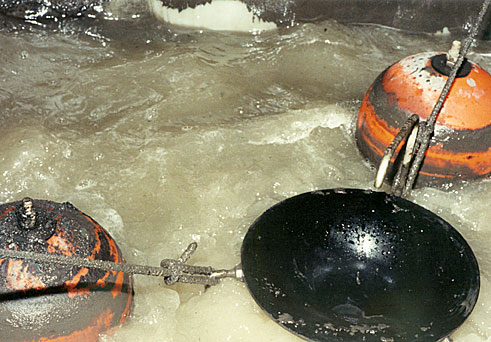 |
| A Bio Reco cleans recycled wash water at a truck depot in Denmark. |
To oxygenate the water in a freshly dug farm pond, a BioReco was installed. This equipment, produced for Biosa, is often used with Terra Biosa to treat unhealthy water. The device is based on the theory that clean water molecules move in an endless whorl. In polluted water that movement is reduced, lowering oxygen and energy content. The BioReco draws in air from the atmosphere and reintroduces or bolsters the whorl pattern, raising oxygen content without stirring up sediment. In fact the increased oxygen, especially combined with Biosa, helps compost the sediment, making the water even healthier.
Terra Biosa also restores a healthful bacterial balance in water that has excess nutrients and algae. It transforms nitrates into nitrogen and oxygen, which escape into the air, so algal growth drops. Biosa organisms also compete for space with anaerobic microorganisms that produce methane and hydrogen sulfide, contributing to an environment that favors the production of beneficial bacteria and fungi. The process varies depending on nutrient supply and on what plant and animal life is present, and on sunlight.
The Langholzes used the BioReco, and every day 10 liters (l) of Biosa were emptied into the pond. After two weeks, the water contained no ammonia; 2 ppm nitrate and 0.5 ppm phosphate. The pond then supplied drinking water for the family’s cows.
Concurrently, each cow received 100 ml of Animal Biosa in its feed daily. Health problems and vet bills decreased, and milk production and quality rose. The white blood cell count, once as high as 600,000 per ml of milk (over the European legal limit of 400,000), dropped to as low as 150,000 after six months of Biosa use, eventually leveling to an average of about 275,000 units. Diarrhea that had afflicted as much as 60% of the cattle disappeared.
A little Biosa goes a long way. A liter of Terra Biosa retails for about $30 U.S., Animal Biosa for around $33, but 1 l of bottled Biosa is diluted to become about 35 l of activated product. To produce just over 100 l, 3 l of organic sugarcane molasses are dissolved in 100 l lukewarm water in a clean plastic drum. Three liters of Biosa are added, the mix is stirred well, then is covered to exclude oxygen. The mixture is kept at around body temperature for five days using an aquarium heater, then is stirred to release CO2, and surface scum is removed. Another three days completes the activation. Qualities of activated Biosa are retained for up to a month if it’s kept airtight, out of the sun, and around 50 to 60 degrees F.
Manure from the Langholzes’ 63 black and white Frisians and German Red Pieds had no smell when I visited, and the cows looked sleek and fit – and had no flies.
The Langholzes found that collected manure treated with Terra Biosa generates more clover when it’s sprayed on fields where cows will graze (and manure from animals getting Biosa with their feed is already an improved and more beneficial product). Animal Biosa also goes on hay that is mixed with clover and siloed for winter feeding. Corn planted in treated areas had bigger, wrinkle-free kernels.
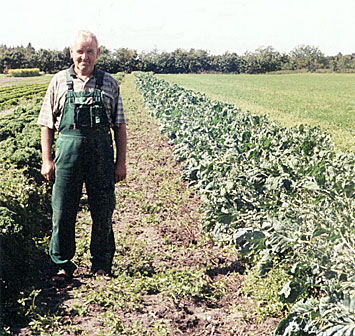 |
| European organic farmer Frede Larsen produces such yields with Biosa that his organic produce is priced no higher than similar, non-organic goods. |
Greater Yields, Lower Prices of Organic Crops
Frede Larsen, who has farmed traditionally for 13 years and organically for over 25 more, operates the Bigård farm in Denmark. In 1996 he sprayed Terra Biosa on cukes and tomatoes and liked the results enough to make it an integral part of his mixed vegetable farming. Larsen’s yield and quality are up, and so is the longevity of harvested crops.
Amazingly, one of Larsen’s plants produced 48 pumpkins, some of which showed no sign of decomposition when I visited the farm a few years later – due to the antioxidant properties of Biosa, says Larsen. He irrigates his greenhouse crops weekly with Terra Biosa, spreads treated vegetable waste on fields after harvest and in March, machining it into the ground, and sprays his fields every spring. With normal spraying it takes no more than 30 l of activated Terra Biosa, mixed with whatever quantity of water is necessary, to cover an acre.
Larsen showed me carrots picked the summer before. Previously, 50% would be inedible by April; with Biosa, over 95% were still edible – firm, redolent and salable. Larsen now has such bountiful crops that he can charge customers no more than prices for non-organically raised produce.
Incidentally, Larsen uses Biosa to deal with a variety of the weed galinsoga. He dries a quantity of the weed, soaks it in water for two to three weeks, removes and mixes it with a Terra Biosa solution, then sprays the affected area with the mixture. Galinsoga does not reappear. This differs from the “orthodox” use of Biosa on weeds: i.e., applying it to encourage weed growth ahead of the growing season so that weeds can be “harvested” before crops are sown or garden vegetables and flowers go in the ground.
Part of a Democratic School
An interesting stop for a non-Dane was at Båring Højskole in northwestern Funen, Denmark’s second largest island. Båring is part of the “folk high school” system in Denmark – a concept of 19th-century Danish theologian N.F.S. Grundtvig as a way for common people to learn about their religion, history and culture. The student body consists of young adults who live, study and work at school fulltime with their teachers, in an atmosphere resembling home. The schools, with no special entrance qualifications and no exams, are open to applicants worldwide and emphasize learning from one another. The core philosophy is to train people for life in democratic circumstances.
Agriculture at the school is organic, and students eat organic foods. Biosa has been used here since a neighboring farmer introduced it, and the Båring school is now spreading the Biosa word around the world through its agricultural projects in countries as diverse as China, Romania, Iran and Pakistan. In 2001 a contingent from the Punjab, in India, studied Danish organic methods at Båring. I thought that, with the leak at the Bhopal pesticide plant still very much a reality more than 20 years after it occurred, India would seem to need little incentive to seek alternatives to agricultural chemicals.
Ingredient for Holistic Health
In its communications Båring Højskole refers to the “active and holistic environment” provided by folk high schools. This comes back to me almost a year later, in Aldergrove, British Columbia, sitting in a pub with Dencker-Jensen as he outlines the full circle of his professional evolution. He now practices the values of Rudolph Steiner, whom he had read as a young man.
The Austrian philosopher-scientist’s Biodynamic agriculture is a holistic system of farming and gardening that regards the earth as a living organism. Renewing soil to produce vital and deeply nourishing food is essential. Were he with us today, Steiner might not be happy, as the nutritional value of our food has plummeted. The U.N. Food and Agriculture Organization reports that some 25 billion tons of valuable upper soil is lost every year worldwide through erosion and weathering, and that “only 11 percent of the world’s soils can be farmed without being irrigated, drained or otherwise improved” in the first place. While organic farming helps build healthy, moisture-retaining soils and collaborates with nature to replenish soils, a holistic approach is necessary to maintain a mutually beneficial relationship with the planet and its creatures.
Consider bees. Bee populations are declining worldwide, partly because pesticides have weakened their resistance to pests. Why shovel more chemicals on the problem? A well-functioning immune system enables species to rebuff pest attacks, and the quality of the immune system depends considerably on the quality of a species’ environment. Beekeepers are starting to spray a 50/50 solution of Animal Biosa and unchlorinated water on hives’ entrance boards and inner surfaces. They treat the bees’ collecting area as well: woods, orchards, fields, even the water in area ponds and marshes. (Bees can be sprayed with the same solution to calm them, incidentally, eliminating the need for smoke.)
Vital Grapes
What better spot for seeing Biosa’s effects than in the Moselle Valley vineyards in Germany, where Peter Konz grows grapes for his prizewinning Konz Saar Riesling? Konz tells me: “Even organic fertilizers I have not used since 1995.” He does use a homeopathic-type energy-function solution that he produces under license – and he’s sold on the virtues of Terra Biosa. Konz grows on 5 acres within a larger area used by both traditional and organic vintners, with a narrow pathway between individual properties, so methods and results are easily compared. (Fortunately, Konz’s vineyards sit upwind of traditionalists’ chemical sprays.)
The differences between Konz’s vines and grapes and his neighbors’ were an eye-opener. The leaves were more vital, with a different color and shape, and an almost palpable energy: They reach for the sun, while those on chemically treated plants are dwarfed by comparison, and are yellow and brown due to fungal infection. Konz’s grapes were larger, more numerous and juicier.
The organic neighbors had less fungus and generally more grapes per vine than the chemically-treated areas, but fungus was still an obvious problem, and much of the fruit showed signs of struggle.
Konz harvests two weeks earlier than his neighbors, and in recent crops the sugar concentration of his grapes has climbed by 1 to 1.5% – which translates to more alcohol and a higher price for the crop.
Konz’s soil is softer, darker, moister and looks richer than any other. When much of Europe had a terribly long, hot summer in 2003, Konz’s soil maintained a healthy water content. When a heavy rain finally came, the water ran off his neighbors’ fields but was absorbed and retained by Konz’s ground. He believes his soil holds 200% more moisture than it did before.
Dencker-Jensen had told me that abruptly switching from chemical to organic methods can create roller-coaster crop yields for several years before stable yields are achieved. When Terra Biosa is used during the transition, however, production increases immediately and remains elevated. Comparing Konz’s grapes with those of his organic neighbors seemed to confirm these observations.
More Milk from Healthier Cows
Rob Donaldson’s Bradner Farms near Abbotsford, British Columbia, is an organic cow and chicken operation with 1,000 or so Holsteins, some 330 of them active milkers. Donaldson and Willy Fitzl, who oversees the milk-cow operation, thought that adding Animal Biosa to the cows’ diet might be worth the small gamble. The cows’ winter feed consists of peas, corn, barley, flax meal, a little soy meal, vegetable oil (mostly soy), kelp and a multivitamin and mineral mix; in warmer weather the rations account for 40% of their feed, with the rest coming from grazing.
Donaldson introduced Biosa into the feed in July 2004, and compared results of the Holstein Association tester before and after introduction. Each cow received 100 ml per day of activated Animal Biosa mixed with rations (at a cost of roughly 10 cents per cow per day), cutting back to 70 ml per day once healthy intestinal flora were established in the animals’ digestive systems, at a cost of around 7 cents per cow per day.
Dencker-Jensen generalized that Biosa would increase milk output by as much as 20% in underperformers and about 10% in well maintained, organically fed animals. When the tester returned in November, July’s average output per cow of 67 pounds per day had risen to 74, a difference of over 10% after less than three and a half months. Milk fat content increased from around 3.5 to 4%. (Fitzl allows that the increase in rations over pasturing might have been a factor in the rise in milk fat.)
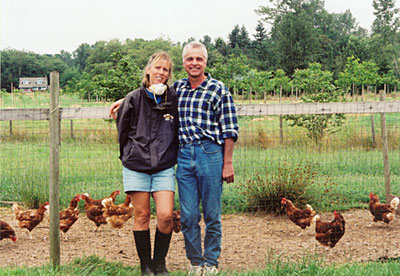 |
| Willy and Monica Fitzl with some of their chickens and walnut trees, pre-Biosa. Masks are no longer needed in the hen house. |
Important as these numbers are, Fitzl enthuses at least as much over the state of the cows’ health, which he estimates improved by at least 50 percent. Cases of mastitis dropped by half, with existing cases being mild enough to be treated homeopathically.
Fitzl and his wife, Monica, raise their own 2,000 layer hens nearby. They started spraying manure in the laying houses with Biosa, eliminating the ammonia odor. (Ammonia is produced when the organic nitrogen in manure decomposes; Terra Biosa, in lowering the manure’s pH, retains the nitrogen and eliminates the smell. The possibilities for Biosa use simply as an odor eliminator in pig and mushroom operations, for example, would seem as vast as the quantities of manure those operations produce or consume.) The manure itself is transformed from a liquid substance that accumulates on boots and clumps on chickens’ claws to a much firmer mass, with a feeling underfoot like forest moss – thick, spongy and minimally moist. (Spraying the air with Biosa also quiets the dust in an enclosed space, and can quiet animals there, reducing aggressiveness.)
The manure can be scraped up or covered with sawdust, eliminating the need for frequent mucking. Fitzl spreads chicken manure every spring between the rows of his 800-tree walnut orchard; now’s he spreading Biosa-treated manure, adding even more Biosa once the manure is on the ground.
An Old Horse Gains Energy, Loses Sensitivity
Father north, in Fort Langley, we stop at Ponder Park Stables to check on a horse named Ricky. A couple of months earlier, stable manager Lisbeth MacQuarry had met Niels Wandler at a health-food store where MacQuarry was trying to find an organic preparation to restore some of Ricky’s old energy. (Wandler ran the Biosa operation in Germany, to date the largest market for the products, before setting up the North American division.) The 13-year-old mount had developed a dull coat and was constipated and listless. Wandler called Dencker-Jensen, who recommended a full liter of Animal Biosa to drink, another liter 24 hours later, and 10 ml a day thereafter. Ricky responded, unburdening himself an hour or two after the first bottle, and producing another five loads over the next day. When we saw him, he was fit, very mobile, and – in stable owner Marilyn Boswyk’s words – had “regained his old vigor.”
Boswyk and MacQuarry had another concern: Ricky was hypersensitive to touch or to being groomed with anything but the softest brush. The sensitivity had diminished with continued Biosa therapy, but Knud suggested an additional treatment: that the horse be ridden until well lathered and that Biosa then be rubbed over his coat to break down the remains of insect life lodged next to his skin. To my knowledge, this was never done, because Ricky’s sensitivity had already become minimal.
Later I was driving with Barrie Briggs, an old hand in food wholesaling in western British Columbia who’s now a Biosa representative. “I’ve been waiting all my life for products like these to come along,” he said. “This is important. This is something that matters.” My mind drifted back to something I’d read by the English poet and art critic Sacheverell Sitwell, who may have summed up the potential of Biosa when he wrote, “Danes seem to have solved of instinct some of the more terrible and besetting problems of living in the modern world.”
About the author: Ron Rosenthall is a freelance writer residing in the oldest farmhouse on the island of Montreal. He grows vegetables that are wholly organic once the traffic exhaust is rinsed off. He can be reached at [email protected].
In Maine, Biosa is available from DMG Solutions Inc. in Pittsfield (www.biosasolutions.com). For ordering or for information from elsewhere, contact Biosa at 1-888-253-7563 or [email protected]. If you try the product, The MOF&G would love to hear about your results.
Backyard Gardeners
For those who won’t be using enough Biosa to concern themselves with activating it, the recommended dose is 1 capful straight from the bottle mixed with 10 l of water, which is roughly the capacity of larger watering cans. Remember, though: Stronger solutions risk composting the plants; and if you use chlorinated water, fill watering cans and leave them under the warm sun for a day or two before Biosa is added to evaporate much or all of the chlorine. The solution should be sprayed on and around vegetables and flowers right after planting, and once a month for the rest of the growing season. Fruit trees can be treated similarly.
